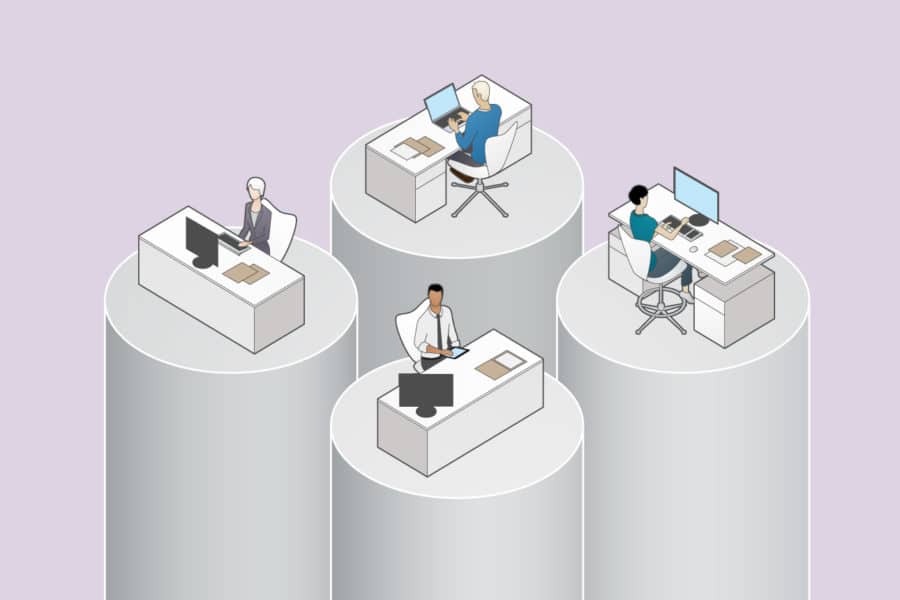
How To Break Down Team Silos At Work
As organizations have grown bigger and bigger, so have their divisions— both literally and figuratively. Specific functions have become decentralized and delegated. As such, the individual components of these organizations have become increasingly specialized and discrete in the form of team silos. Sounds good, right? Not exactly.
There’s one thing that organizations need more than specialization: collaboration and team building.
The hallmark of all successful organizations is effective communication and an atmosphere of collaboration. But team silos, or isolated teams, are formed when the groups work alone rather than together. This reduces productivity and efficiency and slows down progress.
Team building is vital to increasing operational efficiency. If individual silos are not broken down, a unified, productive, and communicative team can’t be built. We know it’s hard to bring teams together and break down team silos across an org, so here are some tips to help.
What Causes Team Silos At Work?
Silos have a place and purpose, and it’s not as a part of a team. Silos are made when people with similar goals and expertise cluster to form an exclusive group. The people in these groups share a vision as well as resources and often create a singular collaborative department. This can be a logistical nightmare, especially when companies want to focus on team building to maximize productivity.
While it is challenging to stop the creation of silos, primarily in organizations that rely on specialized parts, it is the ‘silo mentality’ that managers need to look out for. The ‘silo mentality’ refers to discrete departments hoarding information or resources at the expense of other departments or the organization as a whole. This ‘us vs. them’ mindset leads to unnecessary competition — the formation of team silos is the Achilles’ heel of efficient organizations.

What Is The Silo Mentality?
Modern organizations tend to have vertical and horizontal silos. Horizontal silos are those that exist across the hierarchy amongst departments on the same level. Vertical silos, or those between the higher-level managers and lower-level employees on the same team, also exist. In these situations, communication is limited or lost in translation between the separate silos.
It’s easy to see how silos can become inefficient. However, most companies don’t even realize they’ve been created. This is because silos are intangible. Silos become a part of the company’s culture. Their existence is only confirmed by the operational inefficiency.
This inefficiency becomes evident in the symptoms:
- Delays in achieving results — The organization may not be able to meet its deadlines. This may be visible when the time for the hand-off of the goods or services comes. The hand-off may be to another department or the end-user.
- Rivalry between departments — Teams may be unwilling to share liability if things go wrong. Teams play the blame game and make a distinction between themselves and the other teams.
- Inefficient utilization of resources — This happens when the output does not equal the input. That means that resources are not being used efficiently and teams are complacent. Progress is minimal or non-existent, and no one takes responsibility for the lag.
- Confusion — Individual teams may be unaware of holistic goals. Many times, they may be unaware of other departments and their functions. When the time comes for teams to collaborate on a project, they may not know who to approach or how to approach them.
How To Prevent Silos At Work
One report found that 94% of office workers cite team collaboration as a workplace priority. This proves one important thing: people realize that collaboration is crucial to organizational success. Then why is it absent so often in workplaces? The answer lies with the lack of team building. While silos ensure inter-departmental collaboration, intra-departmental collaboration is often missing.
The goal of an organization should be to break down remote silos and increase connections between teams. Specialized departments can exist, but they should not fall prey to the ‘silo mentality’ and start restricting information. Collaborative opportunities should be present across departments as well as within the departments.
This is where collaboration tools like Hive can come in handy. Hive ensures that your teams are constantly collaborating and sharing the necessary information to help team succeed in the long run. Public projects with subtasks and actions encourage the spread of information in hopes of achieving a common goal, which is crucial when you’re working to build trust and optimize efficiency.
In addition to using a project management tool, exercises that focus on team building can help overcome organizational silos. Here are some example exercises that can help break down silos through team building:
All for one, and one for all
The biggest mistake that managers make when dealing with team silos is ignoring their root cause. Organizational silos exist because there is no common unifying factor. The teams are more invested in their respective team or department’s goals than they are in the organization. In this case, the obvious solution is to foster investment in the organization’s vision.
The mission statement and vision of the organization should be an integral part of the company culture. The vision should not be a vague statement. Instead, it should be an actionable, achievable goal that everyone can relate to. At Hive, we have departmental OKR goals that exist for each team, but they all roll up into a few categories that are consistent for multiple teams in the organization. For example, everyone across the organization is aware of our monthly ARR goals, and we’re all working towards them together — whether that is the engineering team securing a big expansion purchase through the roll-out of a new feature, or the marketing team ensuring the lead pipeline is full.
If people are united by the need or want to fulfill a common goal, they will work together to get there faster. This collaboration is a type of spontaneous team building as individuals and teams cluster together on their own to achieve the desired end.
The IKEA effect
The IKEA effect is an exciting phenomenon that explains why some people are more invested in products they helped create. This effect is a type of cognitive bias in which people have a higher preference for products and ideas in which they had input. The significance of the contribution does not matter — the IKEA effect can be used to increase employee engagement.
At Hive, we’ve got a whole team dedicated to internal innovation, called the “Innovation Pod.” Anyone can submit an idea to this team, and the best of the best will be executed as real features in Hive. This is beneficial because our teams will be more invested in the success of ideas, goods, or services if they are involved in the production.
Therefore, they will engage in behavior that will ensure said success, such as collaboration and cooperation with other departments. This collaboration will create lasting connections between the departments and overcome the barriers of the silos. Ultimately, this increases productivity, trust, morale, efficiency, and innovation.
Cross-departmental interaction
Cross-departmental training and meetings are an essential tool for breaking down organizational silos. People can foster a collaborative environment with other departments by taking part in cross-departmental training. While this will be necessary to broaden their understanding of the organization and its components, it will also help teams understand other teams’ functions and see how they fit inside the larger organization.
Understanding is a core part of team building. Cross-departmental training gives teams a valuable chance to create avenues of cooperation and form connections with other teams that they usually wouldn’t have an opportunity to interact with. Apart from that, additional opportunities for cross-departmental interaction can include non-team activities like lunches. For example, when a new team member starts at Hive, we have 2-3 other Hive employees outside of their team take them out to lunch.
Since we’ve started working remotely at Hive, we’ve also added virtual happy hours and other virtual events to regularly provide opportunities to get to to know others outside of their immediate teams. These non-work-related activities can boost morale and built relationships that will ultimately encourage better teamwork during working hours too.
Additionally, cross-departmental meetings between managers of different departments can also be beneficial. This allows managers to align their departments’ goals with those of other departments as well as the organization. This collaboration can then ‘trickle-down’ to other members of the department and improve cooperation on all levels, not just the managerial one.
Virtual collaboration for team building
As we all know, we’re at a time where workplaces are virtual and many employees work remotely. This changes the opportunities available to create meaningful connections. People who work together as individuals are more likely to build a sense of teamwork and collaborate in group settings too.
A viable solution to maintain collaboration and a productive work environment is the use of team chat applications. Apps like Slack and Hive can have different channels for individual teams as well as the whole organization. This can guarantee that the benefits of specialized silos are retained without the limited communication aspect. By interacting with other teams and individuals, people can engage in team building in a different environment than the traditional workplace.
Sometimes, departments do not collaborate because they do not have appropriate avenues to do so. Sharing information regularly with multiple departments can be a tedious process. By using virtual collaboration and project management tools, organizations can make the process easier. And thankfully, developments in remote work software make it easy to share information promptly and stay connected no matter where you’re working.
Conclusion
Silos serve a very short-term purpose. They help meet the immediate goals of their team or department, but in the long run, the overall productivity and efficiency of organizations suffer, especially when they want to scale. The continuous and free flow of information brings innovation, excitement, and empathy. Therefore a restricted flow of creativity or information in only one department slows innovation and growth, and should be avoided at all costs.
Operational efficiency begins where the ‘silo mentality’ ends. By transcending departmental silos and favoring team building, organizations can achieve its goals more quickly and efficiently.
